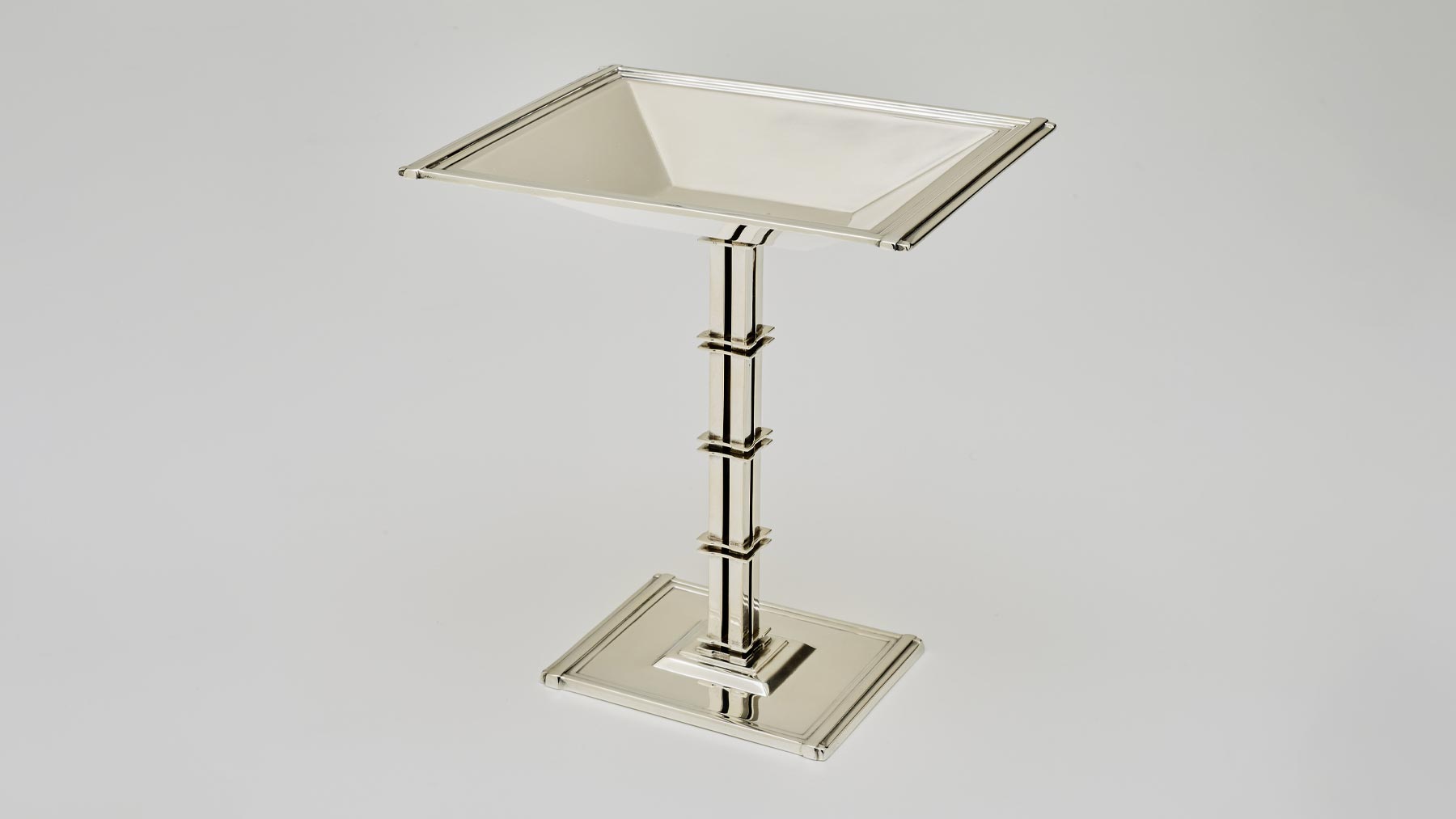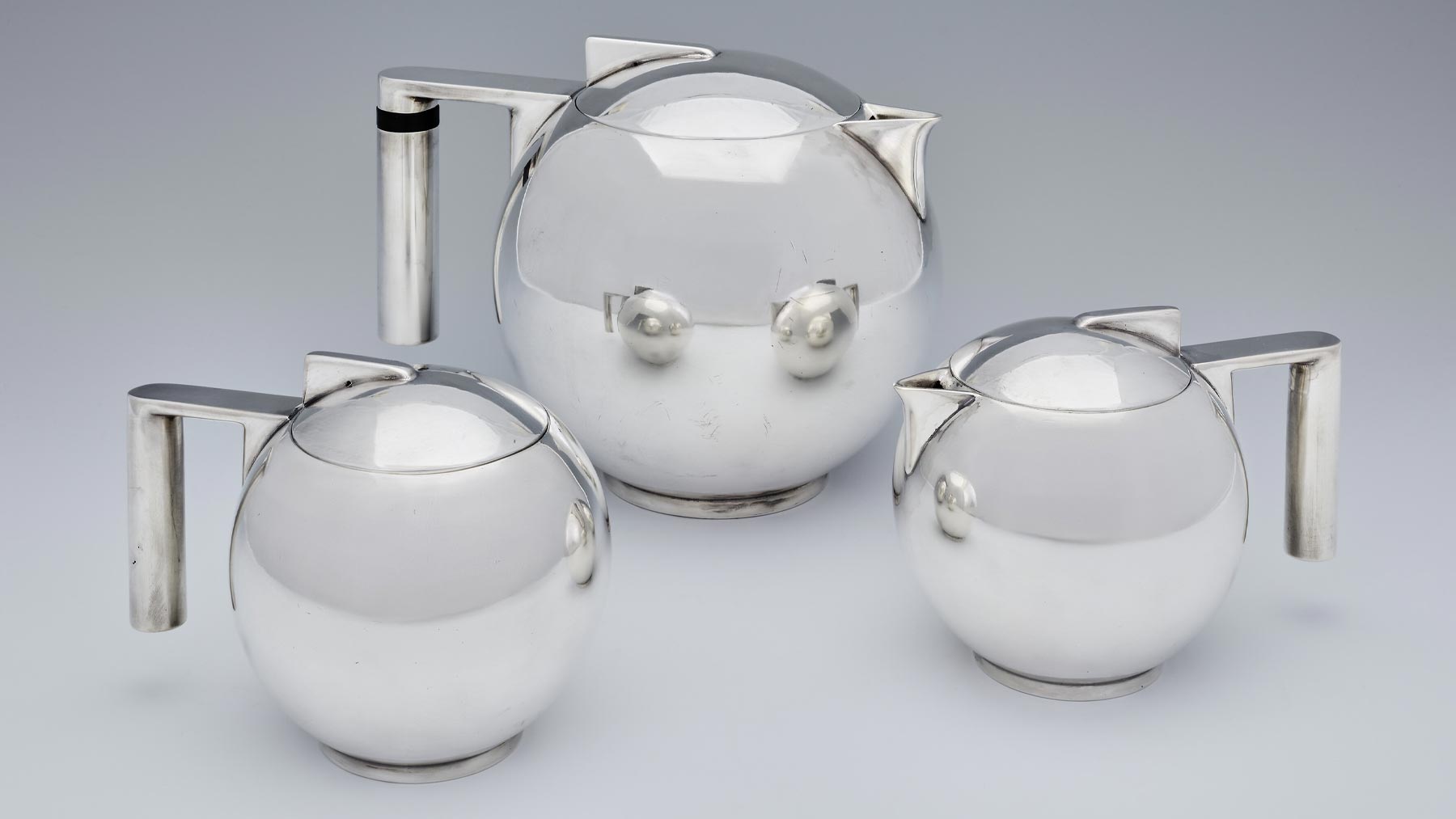
Alongside many other strengths, the Milwaukee Art Museum boasts a remarkable collection of modern American silver. To celebrate these holdings, we wanted to reflect on a few of the significant 20th-century works here at the Museum.
Silversmithing has a long history in the United States, but in the 20th century it emerged as an unexpected medium for the exploration of modern forms and lines. Each an important part of the story of modern silver in the United States, the works featured below express how different designers related to and understood the goals of modernism, and how they worked through a range of ideas around production, craftsmanship, and aesthetics. Some of these objects are currently on view while others will make future appearances in permanent galleries or exhibitions.
“Martelé” Flatware for Rockledge, 1912, by George Washington Maher
Chicago-based architect George Washington Maher designed this flatware for use at Rockledge Estate, a home he built in Winona, Minnesota for businessman Ernest L. King and his family. Maher was a key player in the Prairie School movement, developing a system called “motif rhythm theory,” which applied a consistent and limited number of ornamental motifs throughout a structure and its interior objects to create a single, coherent experience. This approach had its roots in the 19th-century German philosophy of Gesamtkunstwerk, or “total work of art,” and Maher was a strict adherent to it.
For Rockledge, a defining motif was that of the tiger lily. A feature of Art Nouveau design throughout Europe and the United States, the lily’s sinuous curves evinced a naturalistic quality that suited both Maher’s approach and Rockledge’s leafy environs. The flower appears throughout Maher’s designs for Rockledge, including this flatware set. The twelve-piece custom service was produced by Gorham Manufacturing, a major silver maker and competitor with Tiffany & Company. Part of the Martelé line—a name that comes from the French word for “hammered”—the flatware set was made by hand, and six different silversmiths produced each part of the service. Reflecting a contemporary taste for Art Nouveau aesthetics, yet made with a time-honored method, Maher’s Rockledge flatware shows how historic production techniques were still highly prized in American silver in this period.
See the flatware set in the Museum’s 20th- and 21st-century design gallery K116.
“Modernist” Compote, 1928, by Reed & Barton
A venerable sterling silver and silverplate manufacturer, Massachusetts-based company Reed & Barton debuted their Modernist line in 1928. Previously they had focused on historic and colonial revival styles, and an early advertisement for the Modernist campaign reveals, perhaps, some discomfort with a stylized and contemporary style. It exclaims, “faithfully interpreting the spirit of the day, silver in modern design by Reed & Barton takes note of utility, as well as beauty… Here the influences of modern decoration are applied, sensibly, to necessary silver.”
This 1928 compote borrows its form from the tall buildings that marked skylines across the country, but particularly New York, during the 1920s. Skyscraper imagery became popular in that decade, having become synonymous with American enterprise. Harper’s Bazaar noted the similarity between compote and architecture in a June 1929 issue, describing the dish as a “radically modern design deriving its inspiration from the structural steel of a skyscraper.” The openwork supports of the compote stem mimic a tall building’s steel struts, while the shaft appears simultaneously fragile and solid like the steel skeletal frame of contemporary skyscrapers. New to modern design, Reed & Barton nonetheless found inspiration in that most modern of structures, and in doing so pushed American silver to new heights.
The compote is on view through September 8 in the exhibition Beyond Heights: Skyscrapers and the Human Experience.
Covered Cup, 1932, by Arthur Nevill Kirk with Eliel Saarinen (attributed)
Made by Arthur Nevill Kirk, a leading British American silversmith, and likely designed in partnership with Eliel Saarinen, a key figure in American modern architecture, this covered cup is a hybrid object. It sits at the intersection of history, folk culture, and modernism, representing a uniquely American story of craft and design.
Kirk came to the United States from England to join the workshops and faculty at Cranbrook Academy of Art in Michigan, where he worked from 1927 to 1933. It was during this time that he produced this covered cup, likely in collaboration with Finnish American architect Eliel Saarinen. Though the two had a contentious relationship and different aesthetics, they collaborated on a silver container and a footed bowl, both of which bear strong resemblance to this cup. For this reason, despite only Kirk’s name being on the cup, we believe Saarinen likely contributed to the design.
The cup melds Kirk’s taste for restrained and religiously inflected work with Saarinen’s more romantic flair for decoration. Though in the United States he was seen as a modernist, Saarinen, who immigrated to the Unites States from Finland in 1923, was closely aligned with the National Romanticism movement earlier in his career in Finland. He regularly returned to more rustic motifs well into his time in the United States, and the blocky grouse—a national bird of Finland—on the finial of the cup reflects Saarinen’s approach of marrying Finnish folk culture to his more contemporary tendencies.
This cup reflects the unlikely yet productive collaboration between Saarinen, a key agent of modernity, and Kirk, an artisan whose skill and technique were steeped in history. The cup’s two creators held vastly different perspectives on questions of history, artistry, and modernism. Yet, or perhaps because of their dramatic differences, they produced a work imbued with both elegance and charm.
Tea Service, ca. 1934, by Paul Lobel
Romanian-born American designer Paul Lobel traveled to Paris in 1925 to attend the Exposition Internationale des Arts Décoratifs et Industriels Modernes, the world fair that is considered the birth of Art Deco. Inspired by what he saw in Europe, Lobel returned to the United States and began working with metal. In 1934 he debuted his most ambitious work, a prototype for a tea or coffee service, at the Metropolitan Museum of Art’s exhibition Contemporary American Industrial Art. From the success of that exhibition, he was able to put the set into production with Wilcox Silver Plate Co., a division of the International Silver Company.
The service’s remarkable design embodies the forward-looking spirit that Lobel would have encountered at the 1925 Paris fair. Lobel reduced the service into an exercise in geometric asymmetry, with the spheres of the vessels counterweighted by the triangles of finials and spouts. The handles cantilever out from their respective bodies, a gesture that recalls architecture or engineering more than the domesticity of a tea set.
Lobel might have been inspired by the work of Jean Puiforcat, a French silversmith, but the service might also borrow some inspiration from Eliel Saarinen’s own tea urn, designed between 1922 and 1923 and manufactured by Wilcox as well. Regardless of the inspiration, Lobel’s set shows how many modern designers rejected traditional decoration in favor of clean, machined lines and surfaces.
“Silvermode” Vase, designed 1934; produced 1935, by Peter Müller-Munk
German American émigré Peter Müller-Munk was an important figure in the field of industrial design in the 20th century. Working across media over his career, he managed a design consultancy and helped professionalize the field, but he never forgot his roots as a silversmith. When he arrived in the United States as a young man in 1926, he quickly joined Tiffany & Company. He left the firm a year later to pursue greater creative autonomy over his work, opening an independent metalworking studio in Greenwich Village.
Müller-Munk experienced a meteoric rise in the luxury silver market in the late 1920s and 30s. In 1934 he designed a silver-plated houseware line for the Poole Silver Company. This Silvermode line was included in the Metropolitan Museum of Art’s 1934 exhibition Contemporary American Industrial Art, the same installation that featured Paul Lobel’s tea service, above.
This Silvermode vase features Müller-Munk’s characteristic attention to detail and simple, refined lines. Here, a cylindrical body flares outward at the rim, while eight rounded ribs with pointed tips rise from the base and mark the circumference of the vessel. The ribs, while aesthetically compelling, also served a functional purpose: Müller-Munk explained, “A goblet has to feel right in the hands. There should be no slippery surfaces. Hence spikes, because they help you grip the cup.” That mix of practical thinking and stylistic expression marked Peter Müller-Munk’s work throughout his career as he shifted from luxury silver to more widely available engineered products and design projects.
“Circa ‘70” Tea and Coffee Service, designed 1958; produced 1960, by Donald Colflesh
Donald Colflesh was hired by Gorham Manufacturing in 1956 to usher in a new era of design for the firm and reinvigorate the silver market, which had declined following World War II. Founded in Providence, Rhode Island in 1831, Gorham focused on luxury silver goods that reflected the height of craftsmanship—they were responsible for the production of George Washington Maher’s Rockledge flatware, above. During the Second World War, however, Gorham committed their services to the war effort by making parts for cartridge cases, tanks, and torpedoes rather than silver luxury goods. Following the war, Gorham sought to reestablish and rejuvenate their business by bringing in new design talent.
The firm recruited Colflesh while he was a student at Pratt Institute in New York. When he graduated, Colflesh joined the company and soon after designed the Circa ‘70 Tea and Coffee Service, so called because the design felt as if it had come from the future. In addition to the tea and coffee service, the line also included a tri-pronged candelabrum, a pitcher-mixer with mixing spoon, and two bowls.
The Circa ’70 design was a response to the Space Race between the United States and the Soviet Union. Following the launch of the Russian Satellite Sputnik on October 4, 1957, the fascination with space and America’s role in advancing to the next frontier further intensified in popular culture and fine arts. Although designed in 1958, Gorham introduced the Circa ’70 collection in 1960. A pamphlet accompanying the pieces suggested space travel as a source of inspiration, with the line evoking “a feeling of flowing vertical motion…the upward look to space.” Taking a heritage silver company into the future, Colflesh’s design reflects how American silver designers updated to match the times and even get ahead of them.
Curious to know more about the Museum’s 20th- and 21st-century design collection? Continue learning online by checking out A Closer Look: Ruth Asawa’s Milwaukee Connection, which delves into the fascinating life and art of Ruth Asawa. To explore even more important and distinctive examples of design, visit the ever-changing galleries filled with objects spanning the Arts and Crafts movement to Postmodernism and beyond.

Shoshana Resnikoff is the Demmer Curator of 20th- and 21st-Century Design and oversees the research, exhibition, and acquisition of modern and contemporary design for the collection.
Image:
1. George Washington Maher (American, 1864–1926), Manufactured by Gorham Manufacturing Company (Providence, Rhode Island, founded 1831), Commissioned by Rockledge (Ernest L. King House) Homer, Minnesota. “Martelé” flatware with Tiger Lily for Rockledge (Ernest L. King House, Homer, Minnesota), 1912. Silver with gold wash. Purchase, with funds from Demmer Charitable Trust in honor of Nicole Teweles and the Teweles family, M2021.643a–l. Photo by John R. Glembin
2. Manufactured by Reed & Barton (Taunton, Massachusetts, founded 1824). “Modernist” Compote, 1928. Sterling silver. 7 3/8 × 6 11/16 × 5 3/8 in. Purchase, with funds from the Demmer Charitable Trust, M2021.631. Photo by John R. Glembin
3. Arthur Nevill Kirk (American, b. England, 1881–1958), Attributed to Eliel Saarinen (Finnish, active United States, 1873–1950). Covered Cup, 1932. Sterling silver. 5 1/4 × 4 1/8 in. Purchase, with funds from Demmer + Goisman Foundation in honor of Mark McDonald, M2023.174. Photo by Cleber Bonato
4. Paul A. Lobel (American, born Romania, 1899–1983), Manufactured by Wilcox Silver Plate Company (a division of International Silver Company) (Meriden, Connecticut, 1867–1961). Manufactured by International Silver Company (Meriden, Connecticut, founded 1898). Tea Service, ca. 1934. Silver plated metal and ebony. Purchase, with funds from Demmer Charitable Trust in honor of Emma Uhrig Demmer, M2021.778.1a,b–.3a,b. Photo by John R. Glembin
5. Peter Müller-Munk (American, b. Germany, 1904–1967), Manufactured by Poole Silver Company (Taunton, Massachusetts, 1892–1971). Vase, “Silvermode” Line, designed 1934; produced 1935. Silver plate on brass. 5 1/2 × 3 7/16 in. Diameter. Purchase, with funds from the Demmer Charitable Trust, M2021.632. Photo by John R. Glembin
6. Donald Colflesh (American, b. 1932), Manufactured by Gorham Manufacturing Company (Providence, Rhode Island, founded 1831). Circa ’70 Tea and Coffee Service, designed 1958; introduced 1960. Silver, ebony, and Formica. Purchase, with funds from the Demmer Charitable Trust in memory of Max and Shirley Goisman, M2019.117.1a,b–.5. Photo by John R. Glembin





